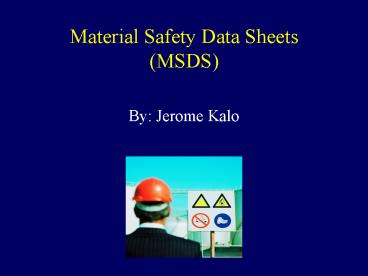Material Safety Data Sheets MSDS - PowerPoint PPT Presentation
1 / 20
Title:
Material Safety Data Sheets MSDS
Description:
... drywall sanders, and brick masons: risk inhaling particles of dust, ... Welders and other metalworkers: risk inhaling metal fumes, which can cause lung ... – PowerPoint PPT presentation
Number of Views:240
Avg rating:3.0/5.0
Title: Material Safety Data Sheets MSDS
1
Material Safety Data Sheets(MSDS)
- By Jerome Kalo
2
What is a Material Safety Data Sheet?
- Form providing detailed information about
hazardous materials present at the worksite. - Hazards addressed
- Chemical
- Health hazards
- Reactivity and fire
- Environmental
3
Hazard Identification
- Blue health Hazard.
- Red flammability.
- Yellow reactivity.
- White other hazard
- 0 no or minimal hazard1 slight hazard2
moderate hazard3 serious hazard4 extreme
hazard
4
Hazard Symbols
5
Who uses MSDS?
- Employees who may be exposed at work.
- Employers who need to know proper storage
methods. - Emergency responders (fire fighters, hazardous
material crews, emergency medical technicians).
6
Responsible for MSDS
- General Contractor/Employer
- Communicates hazards to employees at risk.
- Ensures MSDS is readily accessible during each
work shift. - Passes all MSDS to owner upon completion of
project. - Project manager
- Receives the MSDS from each subcontractor or
supplier.
7
OSHA Regulations
- Regulations 1926.59 1910.1200.
- General Industry Standards for Hazard
Communication. - MSDS must be available to employees for
potentially harmful substances handled in the
workplace.
8
MSDS Format
- No standard format.
- Two main formats utilized
- OSHA
- ANSI
- Can be hardcopy, computer, fax, etc.
- Must contain basic informational requirements.
9
Overview Required Information
- Identity
- Physical properties
- Toxicity/Carcinogen
- Reactivity
- Health effects
- Exposure limits
- First aid
- Storage
- Disposal
- Protective Equipment
- Spill hazard procedures
- ID organization responsible for preparing the MSDS
10
Required Information
- Identity Physical Properties
- Name of product/ chemical name.
- Flash point, melting point, boiling point, etc.
- Toxicity
- Defined in OSHA 29 CFR 1910.1200 Appendix A
- Lethality of a substance in albino rats how
dangerous it is and method of poisoning
(inhalation, skin contact, ingestion). - Whether chemical is considered a carcinogen.
11
Required Information
- Health effects
- Detrimental effects of a substance on the human
body. - First aid
- Information which would help in rendering medical
assistance.
12
Required Information
- Storage
- Proper handling and storage techniques.
- Disposal
- Most substances cannot go down the drain or in
the trash can.
13
Required Information
- Reactivity
- Potential hazards of reaction with other
substances (air, water, chemicals). - Protective Equipment
- Listing of equipment to use when working with the
chemical (respirator, goggles, gloves, apron).
14
Additional Required Information
- Contact information for the manufacturer of the
substance. - Important facts not included in previous
sections - radioactivity
15
Location of MSDS on Jobsite
- Compiled by site safety or management personnel.
- Kept in a binder in jobsite trailer.
- Must ALWAYS be available onsite.
16
Examples Relevance
- Drillers, sandblasters, drywall sanders, and
brick masons risk inhaling particles of dust,
sand, and crystalline silica, which can lead to
lung cancers, tuberculosis, and silicosis. - Welders and other metalworkers risk inhaling
metal fumes, which can cause lung ailments,
airway disorders, and cancer. - Asphalt used in paving and roofing has been
linked to throat irritation, nausea, and chronic
lower respiratory infections.
17
Examples Relevance
- Finishing work can breathe in toxic fumes from
paints, adhesives, floor finishes, and other
materials. - Renovation and demolition of old buildings
exposes workers to lead paint, asbestos, and
toxic molds. - www.ehponline.org/members/2002/110-3/focus.html
18
Online Resources
- MSDS.com
- Hazard.com
- MSDSonline.com
19
Summary
- To prevent accidents on the jobsite related to
hazardous substances, it is mandatory to have
MSDS available to employees. - MSDS is also outlines ways to treat incidences
related to exposure of a hazardous substance. - Reference
- National Safety Council. (1985). The facts about
the hazard communication standard A guide
book. - Illinois National Safety Council.
20
Any Questions?































